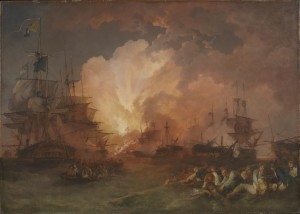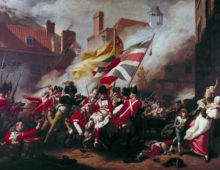Waterloo on Show at Tate Britain
June 30, 2015 - Alwyn Collinson in News
This is a guest article by Greg Sullivan, Tate Britain Curator of British Art 1750 – 1830, and curator of the new Fighting History exhibition open until 13th September.
The responses of artists to military victory is rarely straightforward. A walk around Tate Britain at present will tell you less about what happened at Waterloo or any of the other battles of the Napoleonic wars, and more about how artists create a work of art by reference to an event, or even express a response to the memorialisation of an event.
For a painting to also be a work of art it needs to go beyond being reportage, critique or propaganda. It needs to tell its story, and evoke an elevated emotional and intellectual response to the story. In its highest form the depiction of history becomes istoria, the elevated form of narrative picture that artists aspired to across Europe from the Renaissance onwards.
JMW Turner’s Field of Waterloo (exhibited 1818) is not really a battle scene at all, but a construction of the dreadful aftermath. Turner visited Waterloo in August 1817, equipped with Campbell’s Traveller’s Guide, which mixed descriptions of the battle, and its heroism, with a melancholic account of the massive human cost. In evocative prose mixed with poetry by Byron and others, it described how the moonbeam glittered on polished cuirasses to ‘discover sights of woe, how crops were ‘trodden to earth: arms, accoutrements, tumbrils, cannon, horses, and human bodies strewn in any direction.’ Turner shows us the dead, dramatically lit by illuminating flares, and the bereaved families searching among the dead. The flare lights up, like the lightning flash that heralds the Biblical Deluge in Turner’s earlier, sublime, history painting.
For twentieth-century artists the cultural memory of heroes and events, rather than the events themselves, become the basis for art. Our current exhibition Fighting History: 250 Years of British History Painting investigates the formal properties of British history painting through the last three centuries. In a section of it we refer to Waterloo and the Napoleonic Wars not only through great nineteenth-century history paintings like Philip James De Loutherbourg’s Battle of the Nile, but also through the lens of twentieth-century art.
It has been a controversial choice, but nevertheless one that helps to stress how detached the artistry of history painting usually is from reliance on the actuality of the event. Great history painting, after all, must also ask ‘what is this event to us?’ John Minton’s Death of Nelson, derived from Daniel Maclise’s heroic fresco in the Houses of Parliament (itself painted many years after the fact) is an avant-garde rendering, with the deck of the Victory rendered into a non-perspectival space, the sailors languishing in homo-erotic repose.
Malcolm Morley’s Trafalgar-Waterloo 2013 places a wax and paper cannon, modelled on those on the HMS Victory, between swagger portraits of Nelson and Wellington. Morley has spoken of how his art derived from his childhood obsession with model-making, and he recalled how his model of a battleship, HMS Nelson, was lost in a doodle-bug attack during the Second World War. His desire to create spanned from his constant feeling of childhood loss for a ‘beloved object.’ Morley’s search for a lost emotion through art is a characteristic twentieth-century response to history – not so much a depiction of ‘what really happened’ as an investigation of how we personally connect ourselves to it, and in the process create great multi-layered art.’
Fighting History: 250 Years of British History is open at Tate Britain until 13 September 2015.




